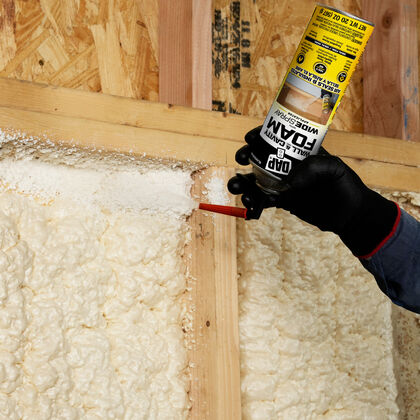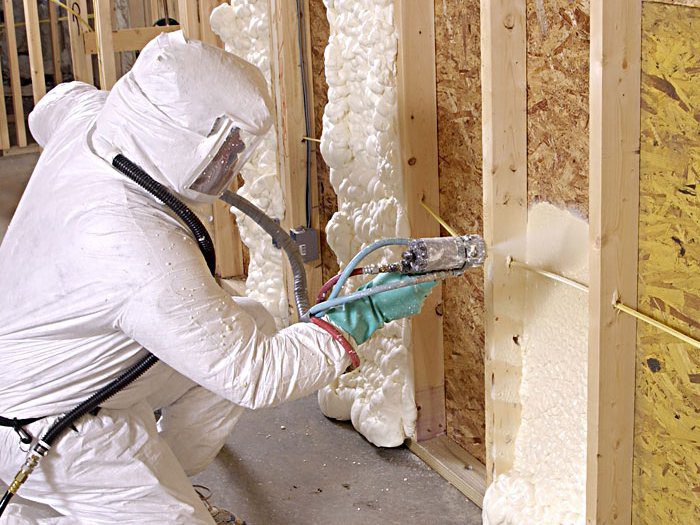Choosing the Right Kind Of Spray Foam for Your Insulation Requirements
Choosing the Right Kind Of Spray Foam for Your Insulation Requirements
Blog Article
Spray Foam: The Ultimate Remedy for Air Sealing and Insulation
Spray foam insulation has actually emerged as a leading solution for reliable air sealing and thermal insulation, offering an unique mix of residential or commercial properties that set it apart from traditional approaches. Understanding the complete range of its advantages, installment processes, and contrasts with other insulation kinds is vital for making informed decisions.
What Is Spray Foam?
Spray foam is a flexible insulation product that combines the principles of air sealing and thermal resistance to boost energy efficiency in buildings. Made up mainly of polyurethane or various other comparable compounds, spray foam is used as a fluid that broadens upon call with surfaces, producing a solid, constant layer of insulation. This unique home permits it to fill spaces, splits, and spaces that traditional insulation materials might forget, supplying a superior air seal.
There are 2 main kinds of spray foam: open-cell and closed-cell. Open-cell spray foam is lighter and a lot more adaptable, offering superb sound absorption and a reduced R-value per inch - Spray Foam. In contrast, closed-cell spray foam is denser, offering a higher R-value, wetness resistance, and included architectural stability to constructing components
The application process typically includes customized tools, making certain a smooth application that complies with various substrates, including concrete, wood, and metal. This versatility makes spray foam appropriate for both new constructions and retrofitting existing structures. Its ability to create an airtight obstacle significantly contributes to lowering power intake and enhancing indoor air high quality, thus making it a preferred option amongst builders and homeowners alike.
Advantages of Spray Foam Insulation
Among one of the most considerable advantages of spray foam insulation is its remarkable ability to develop a constant air barrier, which efficiently minimizes power loss. Unlike standard insulation materials, spray foam expands to load spaces and splits, guaranteeing that air leak is dramatically lowered. This characteristic not just enhances energy efficiency however additionally leads to reduce utility bills over time.
Furthermore, spray foam insulation gives remarkable thermal resistance, contributing to a much more stable indoor setting. Its high R-value per inch allows for reliable insulation in restricted rooms, making it perfect for attic rooms, walls, and crawl areas. The moisture-resistant homes of spray foam aid prevent mold and mold development, promoting much healthier living problems.
Another vital advantage of spray foam insulation is its sound-dampening top qualities (Spray Foam). It successfully reduces noise transmission between spaces, developing a quieter and extra comfortable home setting. The sturdiness of spray foam likewise attracts attention, as it does not sag or settle in time, keeping its efficiency throughout its life-span
How Spray Foam Functions
Recognizing just how spray foam insulation works is essential for valuing its effectiveness in air securing and thermal resistance. Spray foam insulation is composed of 2 main elements: isocyanate and polyol resin. When these components are mixed, they undergo a chemical response that creates the material to expand swiftly, developing a thick foam that fills up splits, spaces, and cavities.
As the foam visit their website increases, it adheres to surface areas, developing an airtight seal that dramatically decreases air seepage. This particular makes spray foam insulation extremely effective at protecting against drafts and moisture infiltration, which can result in power loss and damages over time. In addition, the closed-cell version of spray foam supplies remarkable thermal resistance due to its inflexible structure, effectively decreasing warmth transfer.
The special residential or commercial properties of spray foam permit it to comply with uneven surfaces, making certain thorough protection and a smooth barrier. Consequently, spray foam insulation not just enhances power effectiveness but likewise adds to improved interior air top quality by decreasing the accumulation of irritants and toxins. Ultimately, recognizing the mechanics behind spray foam underscores its function as a premium choice for insulation and air sealing in both household and commercial applications.
Installment Refine Introduction

Before setup, the area has to be properly cleaned up and prepped, guaranteeing that surface areas are without debris, dust, and moisture. Because contaminants can compromise adhesion and overall performance, this step is important. Once the location is prepared, the application involves mixing both components of the spray foam, which broadens upon call and Get the facts loads voids properly.
Educated specialists need to perform the setup, using specialized equipment to ensure uniform protection and optimal thickness. Security safety measures, including wearing safety equipment and making certain appropriate ventilation, are necessary during this process. After application, the foam commonly remedies swiftly, developing a solid obstacle that enhances power efficiency.
Contrasting Spray Foam to Standard Insulation
When reviewing insulation choices, spray foam insulation stands apart in contrast to conventional products such as fiberglass and cellulose. One of the key advantages of spray foam is its remarkable air sealing capacities. Unlike fiberglass and cellulose, which can allow air seepage, spray foam expands upon application, loading crevices and voids to check my reference create a closed seal. This results in improved power effectiveness, as less warmed or cooled down air leaves the home, leading to lower energy bills.
Additionally, spray foam offers a higher R-value per inch than typical insulation kinds, offering even more reliable thermal resistance in a thinner profile. This characteristic is especially beneficial precede with minimal cavity depth. Spray foam is immune to wetness and mold growth, which can be a considerable worry with cellulose and fiberglass, specifically in damp environments.
Nevertheless, spray foam insulation typically carries a higher in advance cost than its typical equivalents. Homeowners must consider this initial investment versus lasting power cost savings and performance advantages. Inevitably, while both insulation types serve their function, spray foam emerges as a more advanced remedy for contemporary insulation requirements, specifically in regards to air sealing and thermal performance.

Conclusion
In summary, spray foam insulation stands for a highly effective option for attaining optimal air sealing and thermal resistance. Its special properties, including wetness resistance and audio dampening, make it ideal for various applications in both new constructions and retrofitting jobs (Spray Foam). The preliminary costs might be higher compared to traditional insulation products, the long-lasting benefits, such as considerable energy savings and improved interior air top quality, warrant the financial investment and highlight its value in modern-day structure methods.
Spray foam insulation has emerged as a leading solution for effective air securing and thermal insulation, using a special combination of residential or commercial properties that set it apart from typical approaches.Spray foam is a flexible insulation material that combines the concepts of air securing and thermal resistance to enhance power effectiveness in buildings.When evaluating insulation alternatives, spray foam insulation stands out in comparison to traditional products such as fiberglass and cellulose. Eventually, while both insulation kinds serve their purpose, spray foam arises as a more innovative option for modern insulation demands, especially in terms of air securing and thermal effectiveness.
In recap, spray foam insulation represents a very efficient solution for attaining optimal air securing and thermal resistance.
Report this page